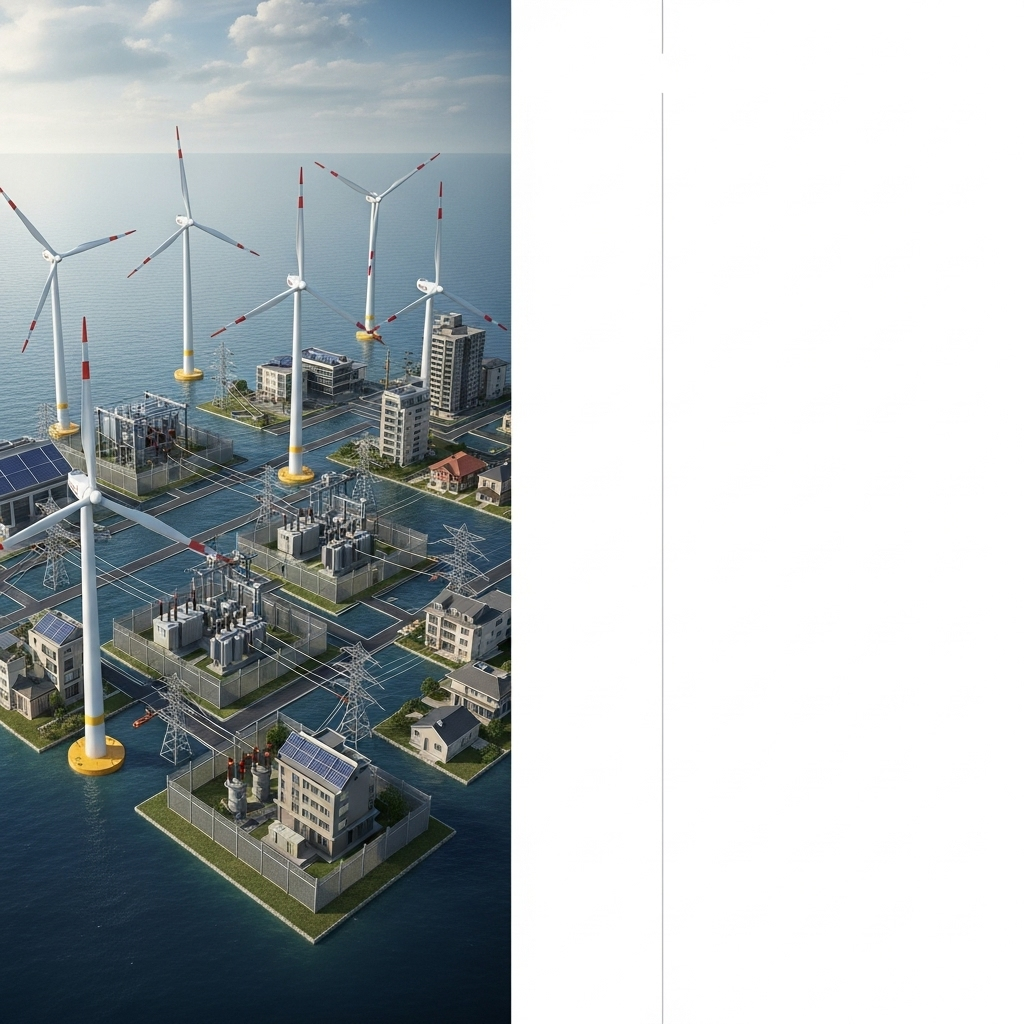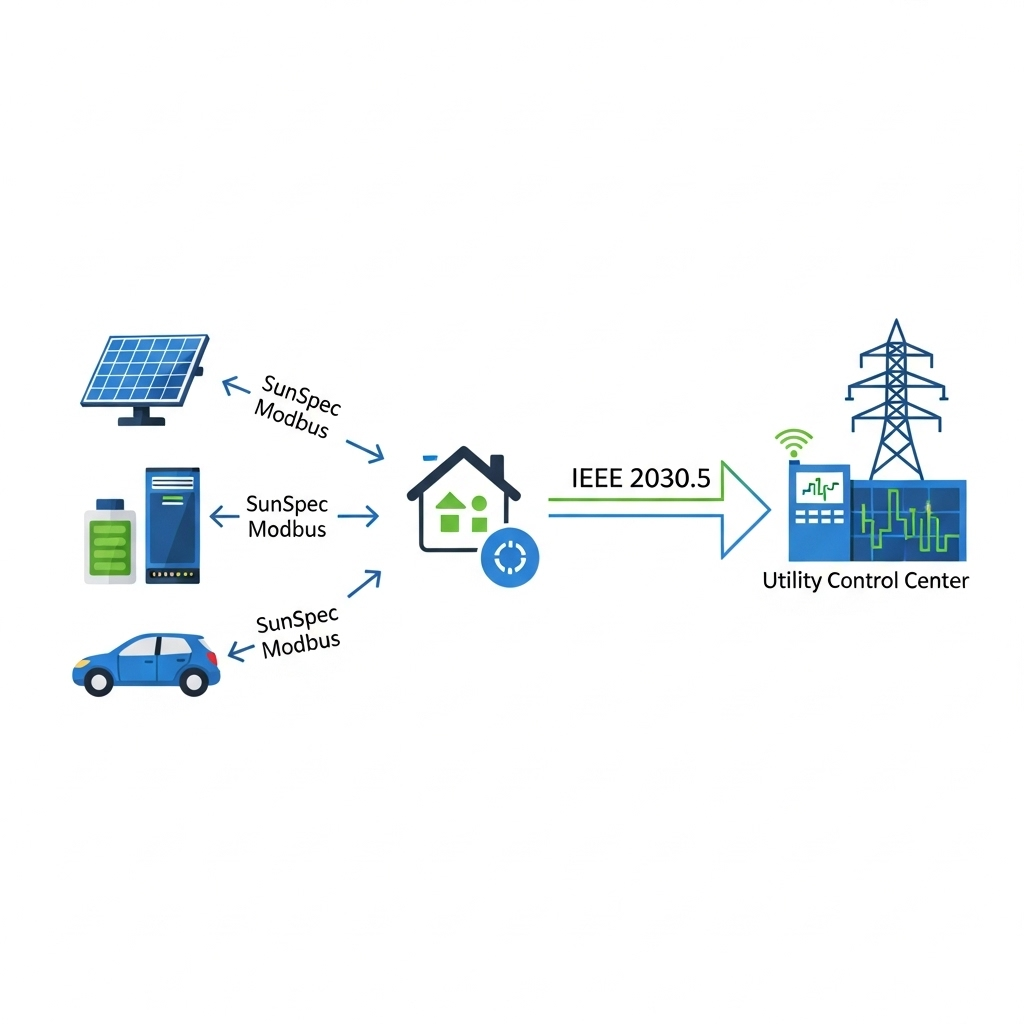As distributed energy resources (DERs) become more integrated into the power grid, standardized communication is no longer optional. For operators managing fleets of hybrid inverters, a unified protocol is the key to unlocking grid services, ensuring stability, and simplifying management. The IEEE 2030.5 standard provides a robust framework for this communication, enabling seamless interaction between DERs and utility control systems. This article outlines a practical path for implementing IEEE 2030.5 across your hybrid inverter assets.
Understanding the Protocol Landscape
Before implementation, it is important to grasp where IEEE 2030.5 fits within the broader ecosystem of energy communication protocols. It acts as a universal language for high-level grid interaction, distinct from the local protocols used by individual devices.
What is IEEE 2030.5?
IEEE 2030.5 is an application-layer protocol designed for smart energy management. It facilitates the transport of energy-related information over IP networks, such as the internet. Originally known as Smart Energy Profile 2.0 (SEP2), it provides a standard way for utilities to communicate with and manage customer-sited resources, including solar inverters, battery storage, and electric vehicle chargers. As noted in the Grid Codes for Renewable Powered Systems report, the foundational IEEE 1547-2018 standard for DER interconnection names IEEE 2030.5 as one of the three primary communication protocols required for compliance, solidifying its role in modern grid infrastructure.
Why It's Critical for Hybrid Inverter Fleets
A single hybrid inverter is relatively simple to manage. A fleet of hundreds or thousands is a different challenge entirely. IEEE 2030.5 provides a scalable solution for managing these fleets as a cohesive unit. It enables advanced grid-support functions like voltage and frequency ride-through, active power control, and demand response. By standardizing communication, operators can avoid proprietary, one-off integrations and build a system that is interoperable with multiple utility programs and platforms.
Positioning with Modbus, CAN, and SunSpec
Your hybrid inverters likely already communicate using local protocols like Modbus or CAN bus. These are excellent for device-level data exchange. SunSpec, in turn, standardizes the *data models* for these protocols, defining what a 'watt' or 'volt' looks like in a Modbus register. IEEE 2030.5 does not replace them; it works above them. A gateway device typically collects data from inverters using SunSpec Modbus and then exposes that information to the utility's network through the IEEE 2030.5 standard.
A Strategic Approach to Implementation
Implementing IEEE 2030.5 is a multi-stage process that requires careful planning in architecture, software development, and security. A phased approach minimizes complexity and reduces the risk of errors.
Phase 1: System Architecture and Protocol Mapping
The first step is to design the communication pathway. This involves a gateway or aggregator that acts as the central brain for the inverter fleet. This gateway polls individual inverters for their operational data. The core task here is protocol mapping: translating the data points from their native format (e.g., SunSpec Modbus registers) into the corresponding resources within the IEEE 2030.5 information model. This mapping is the foundation of the entire system and must be precise.
Phase 2: Security and Network Configuration
Security is a non-negotiable aspect of IEEE 2030.5. The standard mandates the use of Transport Layer Security (TLS) to encrypt all communications between the DER system and the utility. Authentication is typically handled using client-side certificates issued by a trusted Certificate Authority (CA). On the network side, you must configure firewalls to allow secure traffic on the designated ports and ensure the gateway has a stable, reliable internet connection to prevent communication dropouts.
Bridging the Gap: From Local Protocols to IEEE 2030.5
The real technical work happens in the translation layer, where device-level data becomes utility-grade information. This is typically handled by a dedicated gateway device or software platform.
The Gateway as a Protocol Translator
The gateway's primary function is to act as a translator. It speaks 'Modbus' to the inverters and 'IEEE 2030.5' to the utility. It periodically polls each inverter for its status, aggregates the data, and presents it through a compliant IEEE 2030.5 server interface. When the utility sends a command, such as a request to curtail power, the gateway receives the command via IEEE 2030.5, validates it, and translates it into the appropriate Modbus write commands for the targeted inverters.
Data Model Translation: SunSpec to IEEE 2030.5
Translating data models is the most intricate part of the implementation. You must map specific SunSpec Modbus registers to their logical counterparts in the IEEE 2030.5 object model. For example, the active power reading from an inverter needs to be correctly placed into the `DERStatus` function set. Below is a simplified table illustrating this mapping.
| SunSpec Modbus Model/Register | Description | IEEE 2030.5 Resource | Description |
|---|---|---|---|
| Inverter Model (`W`) | Instantaneous active power | `DERStatus.w` | Current signed active power |
| Inverter Model (`Hz`) | Grid frequency | `DERStatus.hz` | Current grid frequency |
| Inverter Model (`VAr`) | Instantaneous reactive power | `DERStatus.var` | Current signed reactive power |
| Inverter Model (`St`) | Inverter operational state | `DERStatus.opStat` | Operational state of the DER |
| Nameplate Model (`WRtg`) | Active power rating | `DERSettings.wRtg` | Nameplate active power rating |
Handling Control Commands
Communication is bidirectional. When a utility sends a control command through a `DERControl` object, the gateway must parse it and act. For instance, a `setW` command to limit active power output requires the gateway to send a Modbus write command to the correct register on the specified inverters. A robust system includes a feedback loop to confirm the command was executed and report the new status back to the utility via an updated `DERStatus` publication.
Testing, Certification, and Deployment
A successful implementation does not end with development. Rigorous testing and formal certification are required to ensure your system is truly grid-ready.
Pre-Certification and Lab Testing
Before seeking formal certification, it is crucial to conduct extensive in-house and third-party lab testing. As described in the Quality infrastructure for smart mini-grids report, facilities like NREL's Energy Systems Integration Facility (ESIF) allow manufacturers to perform preliminary runs of their technology at actual power levels. This pre-certification testing helps identify and resolve issues with protocol interpretation, security handshakes, and command execution in a controlled environment, saving time and money later.
Navigating the Certification Process
Formal certification is performed by authorized test laboratories. These labs use standardized test harnesses to verify that your implementation conforms to the IEEE 2030.5 standard and any regional profiles like the Common Smart Inverter Profile (CSIP). Passing these tests is the final validation that your system is compliant and can reliably interoperate with utility systems.
Fleet Deployment and Management
Once certified, you can deploy the solution across your inverter fleet. Effective fleet management requires tools for remote provisioning, monitoring communication uptime, and deploying firmware updates to both the gateways and the inverters. The communication principles are also relevant in adjacent sectors; as noted in an Innovation Outlook: Smart charging for electric vehicles, similar standards are essential for integrating electric vehicle charging into the grid, highlighting a broad trend toward standardized energy communication.
Final Thoughts
Implementing IEEE 2030.5 for hybrid inverter fleets is a strategic investment in future-proofing your assets. It moves beyond basic monitoring to enable active participation in the evolving energy marketplace. A successful project hinges on a clear architectural vision, meticulous data mapping, uncompromising security, and thorough testing. For a deeper understanding of how these communication protocols impact overall system efficiency, it's helpful to review the fundamentals of solar storage performance metrics, which are the very data points these protocols transmit. By mastering this standard, you position your fleet to deliver value not only to its owners but also to the broader goal of a stable, resilient, and renewable-powered grid.
Frequently Asked Questions
Can I implement IEEE 2030.5 directly on an inverter?
While technically possible for some advanced inverters with sufficient processing power and memory, it is far more common and scalable to use a gateway device or cloud aggregator. This approach centralizes the complex logic, security requirements, and protocol translation, allowing the inverters to remain focused on their core power conversion tasks. It also simplifies fleet-wide updates and management.
What is the difference between IEEE 2030.5 and SunSpec Modbus?
They operate at different levels and serve distinct purposes. SunSpec Modbus is a device-level standard that defines a common set of data points (via Modbus registers) for solar and storage equipment, ensuring different devices speak a common local language. IEEE 2030.5 is a high-level, internet-based protocol used for communication between the entire DER system (as a whole) and the utility's management platform for grid services.
Is IEEE 2030.5 mandatory in the United States?
The national standard for grid interconnection, IEEE 1547-2018, requires that DERs support one of three protocols: IEEE 2030.5, DNP3, or SunSpec Modbus. However, specific utilities and states often have their own preferences. For example, California's Rule 21 and other state-level initiatives strongly favor or mandate IEEE 2030.5 for new DER interconnections. It is critical to consult the technical requirements of the local utility to ensure compliance.





Leave a comment
All comments are moderated before being published.
This site is protected by hCaptcha and the hCaptcha Privacy Policy and Terms of Service apply.